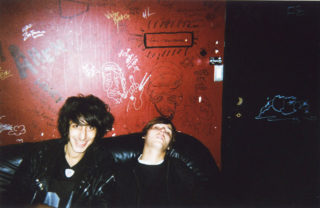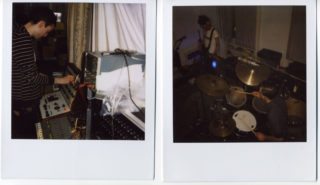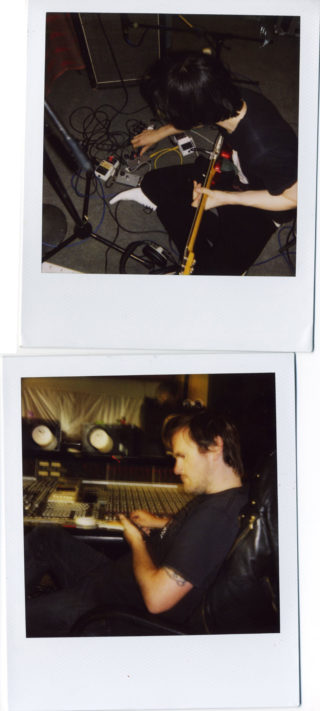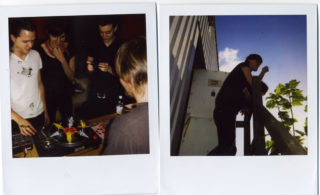The Horrors look back on 10 years of Primary Colours
The left-turn album that changed how everyone felt about the Southend garage band

The left-turn album that changed how everyone felt about the Southend garage band
“We were doing the final mix of the album in Hackney,” Horrors guitarist Josh Hayward tells me, “and I remember walking to do the mix and thinking that if a car came in front of me I could just push it out the way. We were completely intoxicated by it.”
A spring afternoon in the beer garden of a Stoke Newington pub, and the five markedly different personalities that make up the Horrors are slowly assembling; gossiping, fiddling with roll-ups, ordering drinks. They’re here to talk about Primary Colours ahead of a tenth anniversary standalone performance of the record at the Royal Albert Hall on May 9. Not ones for nostalgia, this afternoon is the first time the group have sat down and discussed the record that would transform not only the world inside the Horrors, but the landscape it entered into. This exploratory, psychedelic record – throbbing with violent electronics and doomy soundscapes – would act as an antiseptic to the post-Libertines landfill still dominant in 2009. Its role in ushering in a British psych revival has been under acknowledged, too. For the band themselves, it took them from hyped garage rock fetishists with the wardrobe of an amateur Rocky Horror production to something of an indie institution, with crossover hits and festival headline slots. Just what happened?
Faris Badwan, the group’s faintly diffident, faintly static frontman is the last to arrive – dressed in grey pinstriped suit and black Crombie, he looks for all the world like a 1950s racehorse spiv. The band are already busily chewing over their disputed memories of the time surrounding Primary Colours.
“You have to have people who extremely hate you,” explains Faris, extending an eye over his bandmates, “for you to get the other side as well.” Something about the early incarnation of the Horrors rubbed people up the wrong way. Their 2007 debut, Strange House, certainly found an audience (“we were probably one of the last bands that influenced or inspired kids and fans to really get into the look and come to the gigs looking a certain way,” Rhys Webb tells me. “There were queues around the block of people in drainpipes and polka dots and spiky hair or whatever.”) but the hype (they were NME cover stars before having released an album) and their heavily stylised image forced a potent counter-response. Q magazine called the record “disappointingly insubstantial”, whilst Rolling Stone sneered that the ‘attention-grabbing’ band lacked “the soul to be weird”. Strange rumours abounded: “Some people genuinely believed that we were a jazz band who had heard that indie rock was a goldmine,” Faris scoffs. Tom Cowan, the band’s synth and keyboard player, points out that had someone manufactured the Horrors it would have been a pretty dismal business move. “We still owe Universal £500,000,” says Faris, “and I’m not even exaggerating.”

I myself vividly remember, as a teenager, watching the Horrors, at the tail end of 2007, supporting Arctic Monkeys at Manchester’s cavernous G Mex arena. The mood of the (largely male, largely intoxicated) crowd towards them seethed with rancour: DIY missiles and bodily fluids rained onto the stage. “Those gigs were quite a surprise,” Rhys beams.
“I got £30 in change for the taxi home,” laughs Faris. “They threw all sorts of stuff. Rhys had a black eye – there was an aeroplane seat belt thrown at us; specifically an aeroplane one.”
“…mobile phone batteries, coins heated up by lighters,” continues Rhys. “Before walking out to the second gig, I remember literally getting my eyeliner and smearing it like war paint. Whatever they didn’t like, we just ramped it up and shoved it back in their faces.”
Just what gave the Horrors such nerve; such faith? In rehearsals, both the roles within the group and the sounds they were making were in profound flux. A whole album of material was demo’d and then scrapped; all five members knew that this was the necessary but difficult birth of something new coming into being. In the van, at rehearsals, in the early hours of the morning, they were coming into contact for the first time with ’70s German records, Brian Eno and acid house. “I remember hearing records after nights out,” Tom explains. “Hearing PiL and thinking, hmm… there’s a bit more going on here.” Soon, they were feeding all of this into their rehearsal space in Kings Cross and running around the capital picking up vintage synths.
The first breakthrough was the writing of ‘Three Decades’, the earliest track that would make the cut on ‘Primary Colours’. “That song felt like a signifier,” says Tom. Around this point, Tom was absent from rehearsals one day and Rhys – previously the organ player – decided to pick up the bass. It would be this day that the group wrote ‘Mirror Image’ and ‘Do You Remember’ (he remains, wisely, on bass to this day). “When you started playing bass it was more or less starting from scratch,” Faris tells Rhys, “for me that was what was so cool about it. There wasn’t any fear, it was just instinctive; those songs were written so quickly.” The pace upped and the band were writing four/five songs a week.
“I was literally coming home from rehearsals thinking that whatever has just happened was absolutely amazing,” Rhys says, still exuding the rushing spirit of that moment. “We didn’t ever have a conversation about doing something different – it wasn’t even that we needed to stop doing that – there was just this moment of transition where we were progressing.”
And then, at the start of 2008, the Horrors were dropped by Universal. The band had played their label bosses ‘Three Decades’, as well as the track ‘Primary Colours’. “We thought they were going to love it,” Faris grimaces, “and they just said, these will not get on the radio. The end.” A pause. “I’ve no idea what they actually wanted us to sound like.”
 Buoyed by blind faith alone, the band knuckled down and continued. Their management held their nerve, and in the end The Horrors would remain unsigned for just fourteen days. They were booked to play London’s Astoria in February 2008, and chose to debut a raft of new tracks. The visionary head of XL Records, Richard Russell (who has released his own music with the likes of Sampha and Damon Albarn), went to the shop knowing that the band were now out of contract.
Buoyed by blind faith alone, the band knuckled down and continued. Their management held their nerve, and in the end The Horrors would remain unsigned for just fourteen days. They were booked to play London’s Astoria in February 2008, and chose to debut a raft of new tracks. The visionary head of XL Records, Richard Russell (who has released his own music with the likes of Sampha and Damon Albarn), went to the shop knowing that the band were now out of contract.
“He just said he didn’t care what we wanted to do next, didn’t want to hear the demos, he just wanted to sign us,” explains Rhys.
“He came to the rehearsal studio, we turned off all the lights and played him what we had,” Tom remembers. “He said it was one of the most powerful experiences he’d ever had in his entire life.”
Signed to XL, the group made contact with Portishead’s Geoff Barrow, who had booked the Horrors for his band’s curated ATP festival in 2007. The Horrors had been sharing demos with Barrow, who quickly offered to produce them. Far from being the Svengali-like auteur behind the record that some would paint him as, Barrow’s role was actually one of reigning in the group’s experimentation, and holding a fidelity to their original demos.
“We were all a little disappointed having been excited to get this massive dose of Geoff and all the things he loved,” says Rhys, “when the first thing he said to us was that we should do exactly what we’ve done on the demos.” Rhys concedes now that this was completely correct.
“He said people are going to think that I did this and there’s nothing you can do about that,” recalls Tom, “he anticipated that. But really, his whole thing was saying ‘no’.”
Infatuated with all things electronic and any available studio gimmick, the band remember “driving Geoff insane” during recording. Barrow, meanwhile, spent no small amount of time twiddling knobs to get guitar parts sounding exactly as they did on the demos.
Weekdays were spent recording in Bath, and then, on Fridays, the five Horrors would pile in a car and hurtle up the M4 towards East London for long, thoroughly forgotten weekends of partying. “I can remember us all driving back from London and feeling absolutely terrible, everyone on comedowns,” laughs Rhys, “then getting woken up to go and record a bass part. I think this is important though; we were still really at this point of freedom where everything was happening and songs felt like they were writing themselves, and it’s a magical time that doesn’t last forever. We’d get to a certain point at the end of the day and feel, like, wow what just happened there? What’s going on?”
The high point of recording, the band all agree, was the seven-minute Krautrock-infused opus ‘Sea Within a Sea’. It would be the first track released from the album. Though the band would be painted as connoisseurs pouring over the minutiae of German obscurities, the reality was that their knowledge of bands like CAN, Neu! and Harmonia was actually pretty sketchy. This gives the record much of its character, its spirit; the zeal of the newly converted conveying a first missive. Tom points to the Talking Heads track ‘The Overload’, which conjures an uncanny impression of Joy Division based not on ever having listened to the band, but on what they might sound like having read about them in the music press.
Of course, British bands have been referencing the electronic utopia of Krautrock since the late ’70s, but the internet afforded those records an ease of access which had always been absent – former collectors items are now just a click and an aux cable away. Simon Reynolds’ post-punk study Rip It Up and Start Again was read within the band too. “Just reading that book gives you ideas for ten different bands,” says Faris. “That book was really influential for me.”
They hadn’t heard CAN’s soaring ‘Mother Sky’, nor Neu’s manifesto of minimalism ‘Hallogallo’, but in ‘Sea Within a Sea’ created something that seemed to explicitly reference those records. “That kind of feel,” evokes Rhys, “that kind of rhythm, we hadn’t heard a lot of that music but we just wanted to go for it.” Viewed as a highly considered crystallisation of influences, Primary Colours was anything but. It was a series of first impressions and happy accidents – even the album’s sleeve was a polaroid carelessly taken impromptu at a photo session. As the character Lees puts it in Alan Moore’s From Hell, “I made it up, and it all came true anyway.”

Upon completion, the band were evangelical about the value of what they had recorded; consumed with intoxicating self-belief. “I thought we’d written one of the greatest records in the world,” reflects Josh, “which I think you can only think at that age.” Rough mixes of Primary Colours were handed out to friends, who were startled at the band’s progression. “They thought we were going to do something good,” remembers Tom, “but not as good as this.” The music press too was taking notice, whispers spreading across offices about the novelty band who had shed their skin. (Why does the music press love the narrative of a band they once derided changing tack? It vindicates their platform and status. Look, it says, you listened – and we were right.) Once the glowing reviews came in, Faris remembers feeling mournful and nostalgic for their former Marmite appeal.
Their biggest challenge, however, would be translating the record live. Faris’ frenetic onstage nihilism was perfect for their first incarnation; not quite so for elongated cosmic excavations. The band debuted the record at a sold out show at London’s Rich Mix cinema. “For me, personally, it was a bit confusing what to do on stage,” Faris explains. “Before you could just hurl yourself around the stage and it would be this violent thing, but for that gig in particular I remember my head was kind of split in two.”
The tracks from Strange House had, for Faris, “stopped making sense” – they were tacked on as an encore, and were quietly retired from the set soon after. “We had a crowd of people at the gig who had maybe heard ‘Sea Within a Sea’,” recalls Rhys, “but hadn’t heard anything else. They were quite taken aback, they were used to thrashing about.”
Reflecting on the record, for the band it’s the intensity of that moment that burns brightest. “For me,” Rhys explains, “that album is particularly special because it still feels at the point of youthful freedom, and really being surprised and excited beyond belief at what we were doing.” It was, too, the last album in which they would ever be young.
“In terms of how everything fell into place,” Faris says slowly, “it’s certainly Primary Colours. And… it’s not really within your control whether a record has that.”
Photography by: Faris Badwan